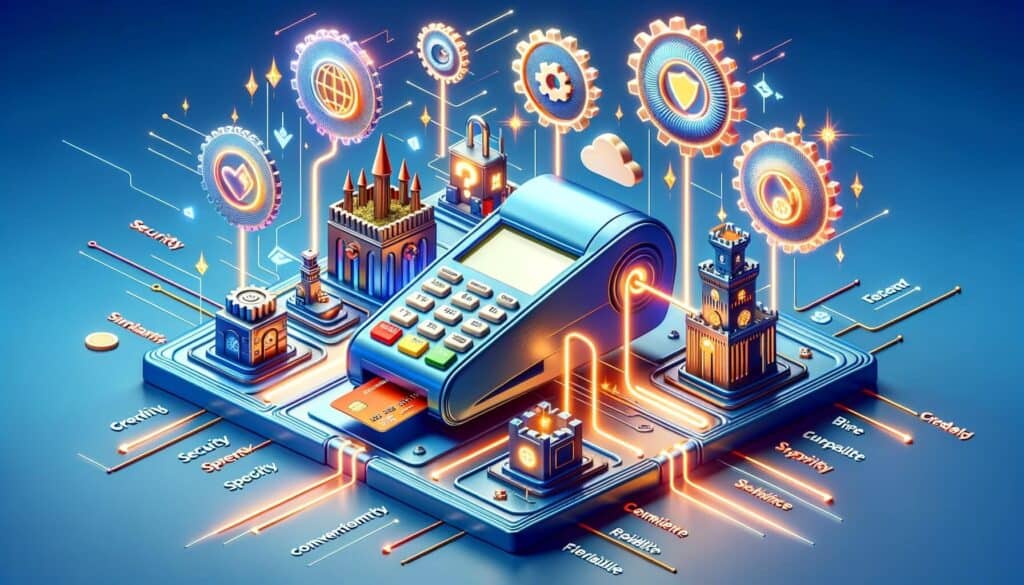
By Amanda Hoglund January 10, 2025
In today’s digital age, credit card processing has become an essential part of running a business. Whether you operate a brick-and-mortar store or an online business, accepting credit card payments is crucial for attracting customers and increasing sales. One of the most convenient and efficient ways to process credit card payments is through a virtual terminal.
A credit card processing virtual terminal is a web-based application that allows businesses to accept credit card payments without the need for physical card readers or terminals. It provides a secure and convenient way for merchants to process payments from anywhere with an internet connection.
In this article, we will explore the ins and outs of credit card processing virtual terminals, including how they work, their benefits, setting them up, key features and functionality, security measures, integration with e-commerce platforms, choosing the right provider, and frequently asked questions.
How Does a Credit Card Processing Virtual Terminal Work?
A credit card processing virtual terminal works by transforming any internet-connected device, such as a computer, tablet, or smartphone, into a payment processing terminal. When a customer wants to make a purchase, the merchant enters the customer’s credit card information into the virtual terminal. The terminal securely transmits the information to the payment processor, which then verifies the card details and authorizes the transaction.
Once the transaction is authorized, the virtual terminal generates a receipt that can be emailed to the customer. The merchant can also choose to print a physical receipt if needed. The funds from the transaction are typically deposited into the merchant’s bank account within a few business days.
Benefits of Using a Credit Card Processing Virtual Terminal

There are several benefits to using a credit card processing virtual terminal for your business. Firstly, it offers convenience and flexibility. With a virtual terminal, you can accept credit card payments from anywhere with an internet connection. This means you can process payments on the go, whether you’re at a trade show, a customer’s location, or even working from home.
Secondly, virtual terminals eliminate the need for physical card readers or terminals. This can save you money on equipment costs and reduce the risk of hardware malfunctions. Additionally, virtual terminals are easy to set up and use, making them a great option for small businesses or those with limited technical expertise.
Another advantage of virtual terminals is the ability to process payments from multiple payment methods. In addition to credit cards, virtual terminals can also accept debit cards, electronic checks, and even mobile wallet payments like Apple Pay or Google Pay. This allows you to cater to a wider range of customers and increase your sales potential.
Setting Up a Credit Card Processing Virtual Terminal

Setting up a credit card processing virtual terminal is a relatively straightforward process. First, you’ll need to choose a payment processor or merchant services provider that offers virtual terminal capabilities. There are many providers to choose from, so it’s important to do your research and select one that meets your specific business needs.
Once you’ve chosen a provider, you’ll need to sign up for an account and provide some basic information about your business. This may include your business name, address, contact information, and banking details for depositing funds. The provider will then review your application and may require additional documentation, such as proof of identity or business registration.
After your account is approved, the provider will provide you with login credentials and instructions on how to access and use the virtual terminal. Typically, you’ll be able to access the virtual terminal through a web browser, so there’s no need to download or install any software.
Key Features and Functionality of a Credit Card Processing Virtual Terminal

Credit card processing virtual terminals offer a range of features and functionality to streamline your payment processing operations. Here are some key features to look for when choosing a virtual terminal provider:
1. Payment Acceptance: A virtual terminal should support the acceptance of various payment methods, including credit cards, debit cards, electronic checks, and mobile wallet payments.
2. Recurring Billing: If your business offers subscription-based services or recurring payments, look for a virtual terminal that supports automated recurring billing. This feature allows you to set up recurring payments for your customers, saving time and effort.
3. Reporting and Analytics: A good virtual terminal should provide detailed reporting and analytics capabilities. This allows you to track your sales, monitor transaction trends, and gain insights into your business performance.
4. Customer Management: Look for a virtual terminal that offers customer management features, such as the ability to store customer information securely, manage customer profiles, and easily access customer transaction history.
5. Integration with Accounting Software: If you use accounting software to manage your business finances, consider a virtual terminal that integrates seamlessly with your accounting software. This can streamline your bookkeeping processes and eliminate the need for manual data entry.
Security Measures and Fraud Prevention in Credit Card Processing Virtual Terminals

Security is a top concern when it comes to credit card processing, and virtual terminals are no exception. To protect sensitive cardholder data and prevent fraud, virtual terminals employ various security measures. Here are some common security features to look for in a virtual terminal:
1. PCI Compliance: The Payment Card Industry Data Security Standard (PCI DSS) is a set of security standards that all businesses accepting credit card payments must adhere to. Ensure that your virtual terminal provider is PCI compliant and follows the necessary security protocols to protect cardholder data.
2. Encryption: Look for a virtual terminal that uses encryption technology to secure cardholder data during transmission. Encryption ensures that the data is scrambled and can only be decrypted by authorized parties.
3. Tokenization: Tokenization is a process that replaces sensitive cardholder data with a unique identifier called a token. This token is used for transaction processing, while the actual card data is securely stored by the payment processor. Tokenization helps reduce the risk of data breaches and minimizes the amount of sensitive data stored on your systems.
4. Fraud Detection and Prevention: Virtual terminals often include built-in fraud detection and prevention tools. These tools analyze transaction data in real-time to identify suspicious activity and flag potentially fraudulent transactions. Some virtual terminals also offer additional fraud prevention features, such as address verification and card security code verification.
Integrating a Credit Card Processing Virtual Terminal with E-commerce Platforms
If you operate an online business, integrating your credit card processing virtual terminal with your e-commerce platform is essential for a seamless payment experience. Most virtual terminal providers offer integration options with popular e-commerce platforms, such as Shopify, WooCommerce, or Magento.
Integration allows you to sync your virtual terminal with your online store, ensuring that all transactions are automatically recorded and processed. This eliminates the need for manual data entry and reduces the risk of errors. Additionally, integration enables real-time inventory management, order tracking, and customer data synchronization between your virtual terminal and e-commerce platform.
When choosing a virtual terminal provider, make sure to check if they offer integration with your preferred e-commerce platform. Look for documentation or support resources that provide step-by-step instructions on how to set up the integration. If you’re unsure about the technical aspects, consider reaching out to the provider’s customer support for assistance.
Choosing the Right Credit Card Processing Virtual Terminal Provider
Choosing the right credit card processing virtual terminal provider is crucial for the success of your business. With so many providers available, it’s important to consider several factors before making a decision. Here are some key considerations to keep in mind:
1. Pricing and Fees: Compare the pricing structures and fees of different virtual terminal providers. Look for transparent pricing with no hidden fees, and consider the overall cost in relation to the features and services offered.
2. Customer Support: Good customer support is essential when it comes to payment processing. Ensure that the virtual terminal provider offers reliable customer support channels, such as phone, email, or live chat. Check for reviews or testimonials from other merchants to gauge the provider’s level of customer service.
3. Compatibility and Integration: If you already use specific software or platforms for your business, check if the virtual terminal provider integrates seamlessly with them. Compatibility with your existing systems can save you time and effort in setting up and managing your payment processing operations.
4. Security and Compliance: As discussed earlier, security is paramount in credit card processing. Ensure that the virtual terminal provider follows industry-standard security protocols and is PCI compliant. Look for additional security features, such as encryption and tokenization, to protect cardholder data.
5. Reputation and Reviews: Research the reputation of the virtual terminal provider by reading reviews and testimonials from other merchants. Look for providers with a solid track record and positive feedback from their customers.
Frequently Asked Questions about Credit Card Processing Virtual Terminals
Q1: What is the difference between a physical card reader and a virtual terminal?
A physical card reader is a hardware device that connects to a computer or mobile device to process credit card payments. A virtual terminal, on the other hand, is a web-based application that allows businesses to accept credit card payments using any internet-connected device without the need for physical hardware.
Q2: Can I use a virtual terminal for in-person transactions?
While virtual terminals are primarily designed for remote or online transactions, some providers offer additional features that allow you to accept in-person payments. These features may include the ability to connect a card reader to your device or use a mobile app for accepting payments.
Q3: Are virtual terminals secure?
Virtual terminals employ various security measures, such as encryption and tokenization, to protect cardholder data. It’s important to choose a virtual terminal provider that is PCI compliant and follows industry-standard security protocols.
Q4: Can I accept payments from international customers with a virtual terminal?
Yes, most virtual terminal providers support international payments. However, it’s important to check if the provider supports the specific payment methods and currencies that your international customers may use.
Q5: Can I process refunds or void transactions with a virtual terminal?
Yes, virtual terminals typically allow you to process refunds or void transactions. The exact process may vary depending on the provider, so it’s important to familiarize yourself with the refund and void policies of your virtual terminal.
Conclusion
Credit card processing virtual terminals have revolutionized the way businesses accept payments. With their convenience, flexibility, and range of features, virtual terminals offer a seamless and secure payment processing solution for businesses of all sizes. Whether you operate a physical store or an online business, a virtual terminal can streamline your payment operations and enhance the customer experience.
When choosing a credit card processing virtual terminal provider, consider factors such as pricing, customer support, compatibility, security, and reputation. Take the time to research and compare different providers to find the one that best meets your business needs.
By leveraging the power of a credit card processing virtual terminal, you can simplify your payment processing, increase sales, and focus on what matters most – growing your business.